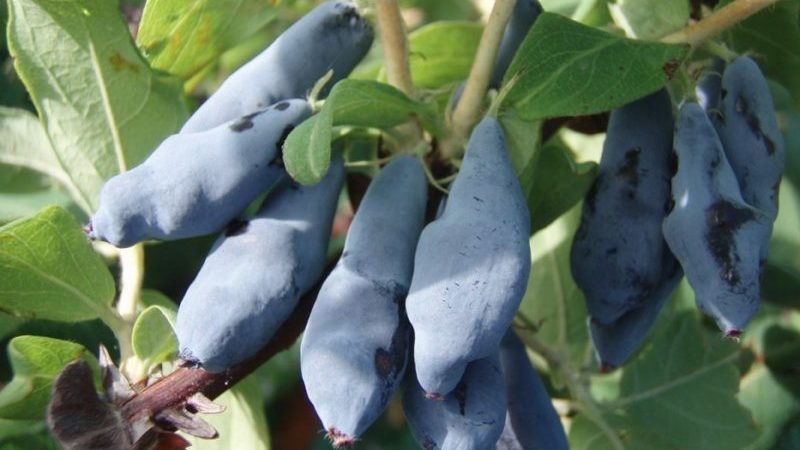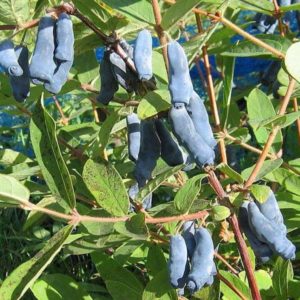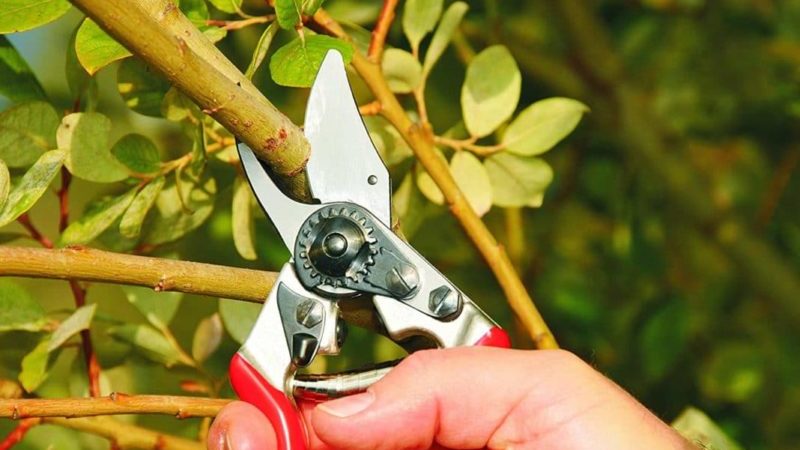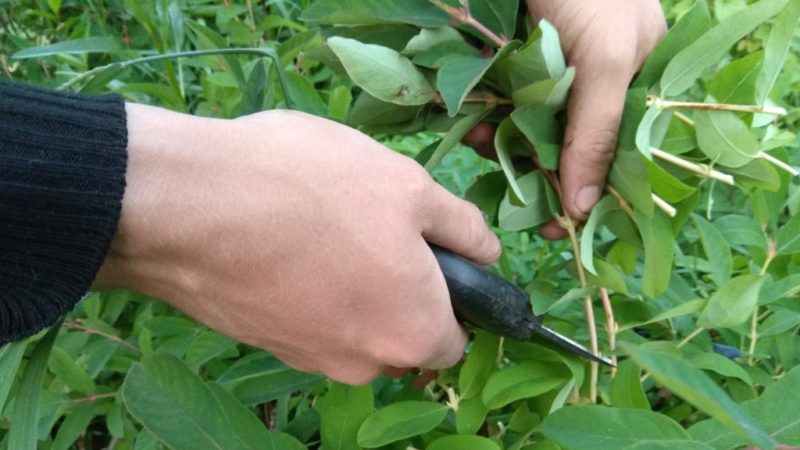Edible Honeysuckle Nymph
Nymph is an edible honeysuckle variety that adapts well to various climatic conditions and is suitable for cultivation in all regions. Among its positive qualities are the pleasant dessert taste of berries, frost resistance and a long productive period. Let's talk about the rules of planting, cultivation and agrotechnical requirements of the Nymph.
The content of the article
Description of the variety
The honeysuckle variety Nymph is the result of the work of domestic breeders. Berries contain 14.3% dry matter, 8.8% sugars, 2.1% acid, 54 mg of ascorbic acid.

Origin and development
The variety was bred in 1992 at the Pavlovsk Experimental Station of the All-Russian Research Institute of Plant Production. NI Vavilov as a result of free pollination of honeysuckle Leningrad Giant. Included in the State Register of Russia in 1998.
Reference. Other names for the Nymph are Gamma, No. 778-11.
Specifications
This is a weakly spreading, vigorous (up to 2.5 m) shrub with powerful erect, pubescent young shoots of light green color. Old branches are lignified, covered with flaky brown-sandy bark.
The leaf plates are large, elongated-oval, with a broadly rounded base, dark green colored and covered with a light hard down. During flowering, large pale bell-shaped flowers are formed in the leaf axils, collected in inflorescences of 2 pcs.
Berries with a bumpy surface, medium size, weigh 0.8-1.1 g, elongated fusiform. Covered with a medium-thick blue skin that looks bluish due to a waxy coating. The pulp is fibrous, with a pleasant aroma and sweet taste with a spicy bitterness. Tasting score - 4.7 points.
Application features
Nymph fruits are of universal use: they are dried, frozen, used to make sherbets, fruit drinks, compotes, jams and preserves, added to desserts and pastries.
Ripening period, yield and fruiting
This is a mid-early variety - the harvest ripens in mid - late June. The bushes begin to bear fruit 3 years after planting and retain their productivity for 25-30 years.
The average yield is 1.3–2 kg per bush, with industrial cultivation - 37 c / ha.
Disease and pest resistance
The shrub is resistant to diseases and pests, but if agrotechnical requirements are violated, it is affected by soot fungus, powdery mildew, tuberculariosis, and is damaged by scale insects, honeysuckle mites.
Cold and drought resistant
Nymph is a frost-resistant honeysuckle. Shoots tolerate a drop in air temperature to -50 ° C, roots - to -40 ° C, and buds, flowers and ovaries do not die during recurrent frosts down to -6 ... -8 ° C.
The variety does not tolerate drought well: a lack of moisture leads to a slowdown in the development of bushes, a decrease in the quality and quantity of the crop. Waterlogging of the soil provokes rotting of the roots and creates a favorable environment for powdery mildew.
Growing regions
Due to its high frost resistance and the ability to adapt to various climatic conditions, the variety is suitable for cultivation in all regions of Russia.
Advantages and disadvantages
Advantages of the Nymph:
- excellent taste and rich chemical composition of berries;
- possibility of growing in all regions;

- long productive period;
- frost resistance;
- stable yield;
- good immunity;
- lack of tendency to shedding fruits;
- unpretentious care;
- decorativeness of the bushes.
Disadvantages of the variety:
- low productivity;
- the need for regular thinning of the crown;
- need in pollinating varieties;
- exactingness to the level of soil moisture.
Differences from other varieties and hybrids
Comparison of Nymph with other medium early varieties of honeysuckle is presented in the table:
| Variety | Berry weight, g | Taste | Berry shape | Productivity, c / ha |
| Nymph | 0,8–1,1 | Sweet, bitter | Elongated fusiform | 37 |
| Moraine | 1 | Sweet and sour | Elongated jug-shaped | 53,3 |
| Glass | 0,8-0,9 | Jug-shaped | 113,2 | |
| Samara | Up to 1 | Sweet | Cylindrical | 100 |
Agrotechnics
In order for the bushes to develop well and bear fruit stably, it is important to choose the right place and timing of planting, to comply with the agrotechnical requirements of the culture.
Choosing a place in the garden and preparing holes
For planting, Nymphs choose a well-lit place, protected from the cold gusty wind, located on a hill or plain.
Reference. Lack of light leads to a decrease in yield and a deterioration in the taste of berries.
The permissible depth of groundwater is at least 1.5 m.
Preparing for landing
When choosing a planting material, preference is given to 2- or 3-year-old seedlings with a developed root system and several strong flexible branches with the same internodes... An hour before planting, the roots are soaked in a solution of a growth stimulant (Kornevin, Heteroauxine).
Site preparation begins six months before planting. The soil is dug up to a depth of 40 cm and spilled with a solution of copper sulfate (1 liter per 10 m²). After 7-10 days, re-digging is carried out to a depth of 20 cm and 10 kg of sand, 10 kg of peat and 20 kg of manure are added per 1 m² of the area. A week before planting the seedlings, the site is once again dug to a depth of 20 cm.
Ground requirements
Shrubs grow and bear fruit best in light, loose and fertile soil with good aeration, moisture permeability and low or neutral acidity. The best option is loam.
When grown in sandstone, yields are reduced, and soil acidity leads to the slow death of the bushes.
Timing, scheme and landing rules
The optimal time for planting a Nymph is from late August to late October. Due to the early growing season, spring planting is undesirable. It can be carried out by transshipment only in the southern regions in the absence of snow (until March 15).
Landing scheme:
- Dig planting holes 40x40x40 cm in size in the prepared area.
- Put a drainage layer of pebbles or expanded clay on the bottom of each.
- Pour nutritious soil mixture on top (1/2 of the dug soil, 20 liters of humus or compost, 60 g of superphosphate and 500 g of ash or chalk) and form a mound.
- Place a sapling on it, carefully spreading the roots along the slopes.
- Cover the voids with earth so that the growth bud is 5 cm below the soil level, tamp.
- Water the planting at the rate of 10 liters of water for each bush.
- Mulch the trunk circle with hay, peat or humus.
The distance between the bushes should be 2 m, the row spacing should be 3 m.
Growing features
On average, plants are watered 4–6 times per season, spending 10–15 liters of water per bush. In the dry season, especially if it falls on the flowering and berry formation phases, the frequency of watering is increased.
Reference. In the southern regions with hot and dry summers, watering is carried out every 7-10 days, consuming 8-10 liters of water per 1 m².
After each watering or rain, the soil is loosened to a depth of no more than 7 cm in order to avoid the formation of a dry crust on the surface of the soil, to improve its moisture and air permeability. To curb the growth of weeds and retain moisture, the soil is mulched with hay, straw, sawdust or humus.
Fertilizers begin to be applied 3 years after planting according to the scheme:
- before the kidneys swell - ammonium nitrate (30 g per 10 liters of water);
- when budding - a bucket of compost diluted with water in a 1: 1 ratio;
- at the end of August - 400 g of ash;
- before the onset of cold weather - 5 kg of compost, 100 g of ash and 40 g of superphosphate per 1 m².
Bushes younger than 15 years old need only sanitary pruning: they remove broken, dry, thickening crown and shoots lying on the ground. For plants aged 15–20 years, thinning pruning is carried out, gradually removing old skeletal branches. When the honeysuckle reaches 20 years old, it is completely cut to a height of 15–20 cm in order to prolong fruiting for another 5–10 years.

Pollinators
Nymph is a self-fertile honeysuckle. To obtain a harvest, suitable pollinator varieties are planted nearby: Amphora, Azure, Chosen, Pavlovskaya, Memory of Gidzyuk, Morena, Viola, Blue Spindle, Leningrad giant.
Disease and pest control
Diseases and pests that are dangerous for a Nymph if the rules for its cultivation are not followed are described in the table.
| Disease / pest | Signs | Treatment / prevention |
| Sooty fungus | The leaves are covered with a dark bloom; with a strong defeat, the plants weaken. | Before flowering, the bushes are sprayed with Bordeaux liquid, Fundazol or Tsinebom (8 g per 10 l of water) twice with an interval of 7 days. |
| Powdery mildew | Leaves dry, covered with white bloom. | Plants are sprayed with Topsin-M or Fundazol. |
| Tuberculariosis | On the shoots, red-brown tubercles are formed, in which spores of the fungus develop. | At the beginning of the growing season, the bushes are sprayed with Bordeaux liquid, pruning is carried out in a timely manner, all damaged shoots are removed. |
| Shield | Insect larvae feed on plant sap, which is why they dry out and die. | Before flowering, 2 times with an interval of 10 days planting is treated with Fitoverm, Aktellik or Confidor. |
| Honeysuckle mite | Leaves curl and fall off. | Before flowering bushes are treated with "Kinmix" or "Iskra", after - "Aktellik" or "Fufanon". |
Preparing for winter
Due to the high degree of frost resistance, the bushes do not need additional shelter. Preparation for winter consists in carrying out in late September - early October water-charging irrigation (20 liters of water per 1 m²) and mulching the trunk circle with compost to a height of 5 cm.
Reproduction

Honeysuckle Nymphs are most often propagated vegetatively:
- By dividing the bush. Mature, well-developed plant dug out and divided into several parts so that each has skeletal branches, young shoots and part of the rhizome. Delenki are planted in a prepared place, having previously shortened the branches to 45 cm.
- Lignified cuttings... At the end of the season, the branches of the annual growth are cut into pieces 15 cm long and removed to the basement, and at the end of March they are planted in a greenhouse, buried in the ground so that 1 bud remains above the surface. After 3-4 weeks, roots will appear on the cuttings.
- Green cuttings. In early summer, shoots are cut into pieces 12 cm long, planted in containers filled with nutritious soil, watered and covered with polyethylene, regularly ventilating and moisturizing the substrate. The cuttings take root within a month, they are planted in a permanent place next fall.
- Apical layers... A furrow is dug under the bush and the top of the shoot is buried in it, fixing it with a bracket. The cuttings take root after 4 weeks. In the fall of the next season, it is separated from the mother bush and planted in a permanent place.
Seed propagation is used only for breeding experiments.
Growing difficulties
Problems that arise when cultivating a Nymph:
- Insect pest attacks. The bushes are sprayed with insecticides and biological products, for example, Fitoverm or Iskra-Bio.
- Powdery mildew damage due to excessive watering or heavy rainfall. The plantings are treated with fungicidal preparations (Topsin-M, Fundazol).
- Decreased number of ovaries, low yield due to drought. The frequency and abundance of watering is increased, the soil in the near-trunk circle is mulched.
Harvesting
Depending on climatic conditions, the harvest ripens in mid or late June. The berries begin to shoot 7-10 days after they turn blue. On the ground, they spread a film and shake the bushes. The remaining fruits are harvested by hand.
The crop is immediately sorted out, getting rid of damaged specimens. Nymph berries are stored in the refrigerator for no more than 2-3 days.
Advice and feedback from experienced gardeners
Gardeners recommend:
- when planting, alternate Nymph seedlings with pollinating varieties in a row every 2 m;
- to improve pollination and attract bees during budding, spray the honeysuckle with a sugar or honey solution (2 tablespoons per 10 liters of water).
Reviews of the variety are positive.
Marina, Ufa: “I like the variety very much: it bears fruit steadily, berries are delicious... An indisputable plus is also that the harvest is easy to harvest, because the bushes are not too dense, and the berries are formed practically in bunches. I propagate the Nymph by apical layers. "
Lilia, Kazan: “I have been growing honeysuckle for a long time, with different varieties. The nymph is one of the favorites. The berries are not very large, but incredibly tasty: sweet, with a slight bitterness. The whole family is happy to eat them fresh, and I also dry them and make jam from them. "
Conclusion
The honeysuckle variety Nymph is suitable for growing in all regions and is characterized by a high degree of frost resistance, a long productive period, stable yield and unpretentious care. Among its disadvantages are self-infertility and exactingness to soil moisture.